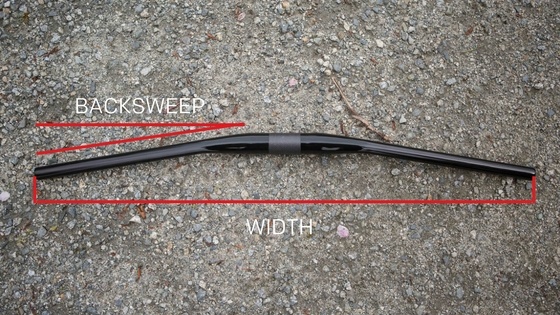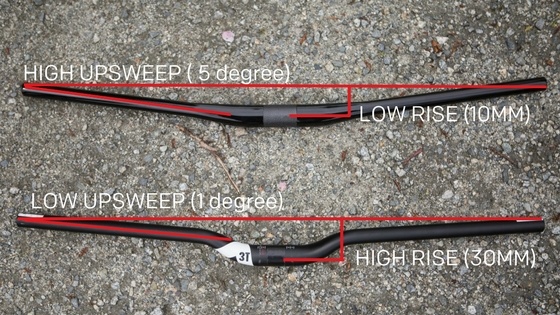Stories posted under Pinkbike Community blogs are not edited, vetted, or approved by the Pinkbike editorial team. These are stories from Pinkbike users.
If a blog post is offensive or violates the Terms of Services, please report the blog to Community moderators.
Handlebar Dimensions Explained
Mountain bike handlebars come in a wide variety of sizes and shapes, and choosing the correct bar for your riding style can really help maximize control, comfort, and ride enjoyment. Before choosing your next mountain handlebar, this guide will help you identify different bar fitting aspects, and how they can impact your ride.
Width:
Mountain bike handlebar width standards have been steadily increasing over the last few years, and you may be asking yourself why. The simple answer is that wider bars give the rider better control over the bike. There are two reasons for this: better leverage and more muscles used. A wider grip stance allows better leverage over the front of the bike, meaning that as you roll over rough terrain, and your front wheel wants to bounce around, it is much easier to hold the line you want. The second reason for the feeling of increased control is that a wider stance engages more of your back muscles. More control, and more power mean a much more stable-feeling ride.
Backsweep:
The average bar has between five and nine degrees of backsweep. The effective backsweep is affected by the angle at which the bar is attached to the bike- rolled forward gives more upsweep and less backsweep, and vice versa. More backsweep gives a more natural hand angle, and is more comfortable, but puts you in less of an ‘attack position’ with your elbows forward to keep weight over the front tire.
Upsweep:
Upsweep is a matter of personal preference, though it is generally considered that around a four degree upsweep is optimal. More upsweep gives the cockpit a feeling of being more supportive in rough descents, but can be harder on the riders wrists.
Rise:
Bar rise is the easiest change to make to adjust the overall comfort of the bike. Higher rise bars take pressure off the rider’s lower back and neck, putting them in a more upright position overall. An upright bar moves the riders center of balance backward, making it easier to lift the front wheel off the ground. Conversely, a lower bar keeps the rider’s weight farther forward, and makes the bike feel more planted and controlled.
Material:
Modern mountain bike handlebars are most often constructed of aluminum, or in some cases carbon fiber. Aluminum has the benefit of being strong, light, and easy to shape, cut to length, and affix to your bike. Carbon fiber handlebars tend to be lighter, deaden vibration better, and flex less under extreme forces. The price of carbon fiber handlebars precludes most people from running them, but their advantages of stiffness and comfort can’t be overlooked. Companies like Spank industries, who refrain from carbon production due to environmental concerns, produce a line of bars with a foam-filled core to deaden vibration, making a bar that feels like carbon at a lower cost. These Vibrocore bars come in a variety of widths and heights to suit any setup.
We hope you have found this bar sizing guide helpful. Remember that your bike should always be comfortable, and if it isn’t, head to your local Live to Play Sports dealer, and they’ll help you get the most out of your ride.
Width:
Mountain bike handlebar width standards have been steadily increasing over the last few years, and you may be asking yourself why. The simple answer is that wider bars give the rider better control over the bike. There are two reasons for this: better leverage and more muscles used. A wider grip stance allows better leverage over the front of the bike, meaning that as you roll over rough terrain, and your front wheel wants to bounce around, it is much easier to hold the line you want. The second reason for the feeling of increased control is that a wider stance engages more of your back muscles. More control, and more power mean a much more stable-feeling ride.
Backsweep:
The average bar has between five and nine degrees of backsweep. The effective backsweep is affected by the angle at which the bar is attached to the bike- rolled forward gives more upsweep and less backsweep, and vice versa. More backsweep gives a more natural hand angle, and is more comfortable, but puts you in less of an ‘attack position’ with your elbows forward to keep weight over the front tire.
Upsweep:
Upsweep is a matter of personal preference, though it is generally considered that around a four degree upsweep is optimal. More upsweep gives the cockpit a feeling of being more supportive in rough descents, but can be harder on the riders wrists.
Rise:
Bar rise is the easiest change to make to adjust the overall comfort of the bike. Higher rise bars take pressure off the rider’s lower back and neck, putting them in a more upright position overall. An upright bar moves the riders center of balance backward, making it easier to lift the front wheel off the ground. Conversely, a lower bar keeps the rider’s weight farther forward, and makes the bike feel more planted and controlled.
Material:
Modern mountain bike handlebars are most often constructed of aluminum, or in some cases carbon fiber. Aluminum has the benefit of being strong, light, and easy to shape, cut to length, and affix to your bike. Carbon fiber handlebars tend to be lighter, deaden vibration better, and flex less under extreme forces. The price of carbon fiber handlebars precludes most people from running them, but their advantages of stiffness and comfort can’t be overlooked. Companies like Spank industries, who refrain from carbon production due to environmental concerns, produce a line of bars with a foam-filled core to deaden vibration, making a bar that feels like carbon at a lower cost. These Vibrocore bars come in a variety of widths and heights to suit any setup.
We hope you have found this bar sizing guide helpful. Remember that your bike should always be comfortable, and if it isn’t, head to your local Live to Play Sports dealer, and they’ll help you get the most out of your ride.
Author Info:
Must Read This Week
[UPDATED] Final Elite XC Results & Overall Standings from the Mairiporã XC World Cup 2024
41957 views
41957 views
Sign Up for the Pinkbike Newsletter - All the Biggest, Most Interesting Stories in your Inbox
PB Newsletter Signup
5 Comments
- 3 0
You're setting the bar for product reviews on pink bike.
- 2 0
*tips hat* Thankya
- 3 1
This was an awesome explanation!
Thanks for that!
- 1 0
Appreciate it!
- 1 0
Straight forward and concise explanation. Thanks
Login or Sign Up




 Member since Apr 26, 2017
Member since Apr 26, 2017